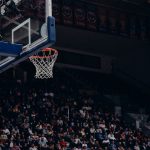Defense is a critical component of basketball that is often overshadowed by offensive plays and high-scoring games. However, successful teams recognize that defense is fundamental to their performance. An effective defense can disrupt the opponent’s offensive strategy, generate turnovers, and create additional scoring opportunities.
Defense is not solely about preventing the opposing team from scoring; it also builds momentum and energy for one’s own team. Even the most skilled offensive players may struggle to win games without a robust defensive foundation. Defense is indicative of a team’s work ethic, discipline, and mutual commitment.
Effective defensive strategies require constant communication, trust, and teamwork to successfully impede the opposing team. A strong defensive unit can potentially demoralize opponents, frustrate key players, and shift the game’s momentum. Defense is not merely about preventing scores; it establishes the game’s tone and allows a team to assert control over their opponents.
It demonstrates resilience, determination, and the commitment to achieve victory through all necessary means.
Key Takeaways
- Defense is a crucial aspect of basketball that can greatly impact the outcome of a game.
- Individual defensive skills such as footwork, positioning, and anticipation are essential for effective defense.
- Team defensive tactics, such as help defense and rotations, are important for covering gaps and preventing easy scoring opportunities.
- Communication and switching on defense are key for maintaining defensive assignments and preventing open shots.
- Anticipating and reacting to offensive moves, such as screens and cuts, is crucial for disrupting the opponent’s offense.
Developing Individual Defensive Skills
Individual Defensive skills
Individual defensive skills are the building blocks of a strong defensive unit. Every player on the team must be able to hold their own on defense,<|start_header_id|><|start_header_id|>assistant<|end_header_id|><|start_header_id|>3>Footwork
Mastering Team Defensive Tactics

While individual defensive skills are important, basketball is ultimately a team sport, and effective team defense requires coordination and communication among all players on the court. One of the most important aspects of team defense is understanding and executing different defensive schemes. This includes man-to-man defense, zone defense, and various hybrid defenses that combine elements of both.
Each of these schemes has its own strengths and weaknesses, and it’s important for players to understand their roles within each scheme. In addition to defensive schemes, mastering team defensive tactics also involves understanding how to help defend teammates and rotate to cover for each other. This requires constant communication on the court, as well as a high level of trust and awareness among all players.
Team defense also involves knowing when to double-team an opponent, how to effectively switch assignments, and how to close out on shooters without giving up driving lanes. Ultimately, effective team defense is about all five players on the court working together as a cohesive unit to disrupt the opposing team’s offense.
Communicating and Switching on Defense
| Player | Communication | Switching |
|---|---|---|
| Player 1 | Excellent | Good |
| Player 2 | Good | Excellent |
| Player 3 | Average | Average |
Communication is absolutely essential for effective defense in basketball. Without clear and constant communication, players will struggle to coordinate their movements, anticipate offensive plays, and cover for each other effectively. This means calling out screens, switches, and help defense, as well as providing verbal cues to teammates about where the ball is and where potential threats are coming from.
Good communication can also help prevent breakdowns in defensive assignments and ensure that everyone is on the same page. Switching on defense is another important aspect of effective team defense. Switching involves two defenders exchanging assignments in order to cover an offensive player who is moving without the ball or setting screens.
This requires good communication and awareness among all players on the court, as well as the ability to quickly adjust and react to changes in defensive assignments. Switching can help prevent open shots and driving lanes for the opposing team, but it requires discipline and coordination to execute effectively.
Anticipating and Reacting to Offensive Moves
Anticipating and reacting to offensive moves is a key skill for effective defense in basketball. This involves reading the body language and movements of offensive players in order to anticipate their next move and react accordingly. For example, a defender may need to anticipate when an offensive player is going to drive to the basket, shoot from outside, or pass to a teammate.
This requires a high level of focus and awareness on the part of the defender, as well as the ability to quickly react and adjust their positioning based on the offensive player’s actions. In addition to individual anticipation and reaction, effective team defense also involves reading and reacting to the overall flow of the game. This includes recognizing offensive sets and plays that the opposing team likes to run, as well as adjusting defensive strategies based on how the game is unfolding.
For example, if a particular player is hot from outside, the defense may need to adjust by closing out harder on shooters or double-teaming that player to force them into more difficult shots.
Utilizing Defensive Drills and Exercises

Adapting Defensive Strategies to Different Opponents
Finally, effective defensive strategies must be adaptable based on the strengths and weaknesses of different opponents. This means scouting opposing teams to understand their offensive tendencies, key players, and preferred sets and plays. By understanding an opponent’s strengths and tendencies, a team can adjust their defensive strategies accordingly in order to take away what the opposing team likes to do best.
For example, if an opposing team has a dominant post player, the defense may need to adjust by fronting the post or bringing help defense from the weak side in order to prevent easy entry passes into the post. If an opposing team has strong outside shooters, the defense may need to adjust by closing out harder on shooters or extending their defensive pressure beyond the three-point line. Ultimately, effective defensive strategies are not one-size-fits-all; they require adaptability and flexibility based on the specific challenges posed by each opponent.
In conclusion, defense is an essential aspect of basketball that requires individual skill development, teamwork, communication, anticipation, and adaptability. By focusing on these key elements of defense and consistently practicing defensive drills and exercises, teams can develop a strong defensive identity that can disrupt opposing offenses and create scoring opportunities for themselves. Effective defense is not just about preventing the other team from scoring; it’s about setting the tone for the game, imposing your will on the opposition, and ultimately securing victories for your team.
If you’re interested in learning more about defensive strategies in basketball, you should check out the article “10 Defensive Strategies Every Basketball Player Should Know” on Mason Basketball. This article provides valuable insights into various defensive tactics that can help players improve their skills on the court. Whether you’re a beginner or an experienced player, this article offers practical tips and techniques to enhance your defensive game.
FAQs
What are defensive strategies in basketball?
Defensive strategies in basketball are tactics and techniques used by a team to prevent the opposing team from scoring. These strategies involve positioning, communication, and physical skills to disrupt the offense and force turnovers.
What are some common defensive strategies in basketball?
Common defensive strategies in basketball include man-to-man defense, zone defense, full-court press, trapping, and switching. Each strategy has its own set of principles and objectives to limit the opposing team’s scoring opportunities.
How do teams decide which defensive strategy to use?
Teams decide on their defensive strategy based on factors such as the strengths and weaknesses of their own players, the strengths and weaknesses of the opposing team, and the game situation. Coaches may also adjust their defensive strategy based on the flow of the game and the performance of their players.
What are the key principles of effective defense in basketball?
The key principles of effective defense in basketball include maintaining proper positioning, communicating with teammates, anticipating the opponent’s moves, contesting shots, and forcing turnovers. These principles are essential for disrupting the opposing team’s offense and limiting their scoring opportunities.
How do players improve their defensive skills in basketball?
Players can improve their defensive skills in basketball through practice, drills, and game experience. This includes working on footwork, agility, reaction time, and understanding defensive concepts. Watching game film and studying opponents can also help players improve their defensive abilities.










